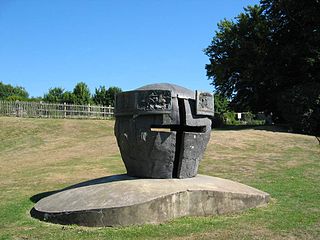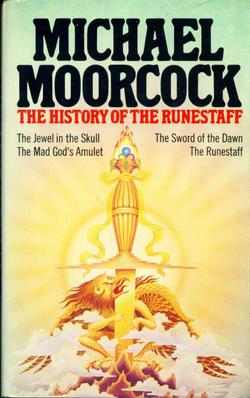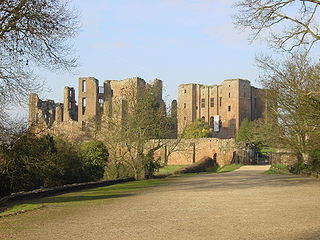
Corum Jhaelen Irsei is the name of a fictional fantasy hero in a series of novels written by Michael Moorcock. The character was introduced in the novel The Knight of Swords, published in 1971. This was followed by two other books published during the same year, The Queen of Swords and The King of Swords. The three novels are collectively known as the "Corum Chronicles trilogy" or "the Chronicles of Corum". Both The Knight of the Swords and The King of the Swords won the August Derleth Award in 1972 and 1973 respectively. The character then starred in three books making up the "Silver Hand trilogy", and has appeared in other stories taking place in Moorcock's multiverse.

Michael John Moorcock is an English–American writer, particularly of science fiction and fantasy, who has published a number of well-received literary novels as well as comic thrillers, graphic novels and non-fiction. He has worked as an editor and is also a successful musician. He is best known for his novels about the character Elric of Melniboné, which were a seminal influence on the field of fantasy in the 1960s and 1970s.

Year 1215 (MCCXV) was a common year starting on Thursday of the Julian calendar.
The 1210s was a decade of the Julian Calendar which began on January 1, 1210, and ended on December 31, 1219.

Year 1264 (MCCLXIV) was a leap year starting on Tuesday of the Julian calendar.

Elric of Melniboné is a fictional character created by English writer Michael Moorcock and the protagonist of a series of sword and sorcery stories taking place on an alternative Earth. The proper name and title of the character is Elric VIII, 428th Emperor of Melniboné. Later stories by Moorcock marked Elric as a facet of the Eternal Champion.
The Eternal Champion is a fictional character created by British author Michael Moorcock and is a recurrent feature in many of his speculative fiction works.

The History of the Runestaff is an omnibus collection of four fantasy novels by Michael Moorcock, consisting of The Jewel in the Skull, The Mad God's Amulet, The Sword of the Dawn, and The Runestaff. Charting the adventures of Dorian Hawkmoon, a version of the Eternal Champion, it takes place in a far-future version of Europe in which the insane rulers of the Dark Empire of Granbretan are engaged in conquering the continent. Written between 1967 and 1969, it is considered a classic of the genre, and has proven highly influential in shaping subsequent authors' works.

The Eternal Champion is a fantasy novel by Michael Moorcock that introduces the hero known as both John Daker and Erekosë. Originally written in the late 1950s, it constitutes the first novel of Moorcock's sprawling Eternal Champion series. The tale was first published in 1962 as a magazine novella Moorcock expanded the novella to novel length for publication in 1970. He revised the text for its 1978 publication. Along with expanding the original story, the novel makes some minor changes to narration and scenes, and also includes references to other short stories by Moorcock. The Eternal Champion is the first in a trilogy of novels known as the Erekosë series. The sequel novels are Phoenix in Obsidian, and The Dragon in the Sword (1987).

The Jewel in the Skull is a fantasy novel by English writer Michael Moorcock, first published in 1967. The novel is the first in the four volume The History of the Runestaff.

The Mad God's Amulet is a fantasy novel by English writer Michael Moorcock, first published in 1968 as Sorcerer's Amulet. The novel is the second in the four-volume The History of the Runestaff.

The Sword of the Dawn is a fantasy novel by British author Michael Moorcock, first published in 1968.
Făt-Frumos with the Golden Hair or The Foundling Prince is a Romanian fairy tale collected by Petre Ispirescu in Legende sau basmele românilor. The tale was also published the title Fet-Frumosu cu perulu de auru, both by author I. C. Fundescu and Romanian folklorist Atanasie Marian Marienescu in newspaper Albina.
Events from the 1310s in England.
Events from the 1260s in England.

The siege of Kenilworth, also known as the great siege of 1266, was a six-month siege of Kenilworth Castle and a battle of the Second Barons' War. The siege was a part of an English civil war fought from 1264 to 1267 by the forces of Simon de Montfort against the Royalist forces led by Prince Edward. The siege was one of few castle attacks to take place during the war.

Louis II, son of Louis I of Vaud of the House of Savoy, was the Baron of Vaud from 1302 until his death. A military man, he fought widely in Italy and, during the first phase of the Hundred Years' War, in France. As a diplomat he visited England and the papal court in Rome and Avignon, and he served as regent of the County of Savoy between 1343 and his death, during which period he was the leader of the House of Savoy.












